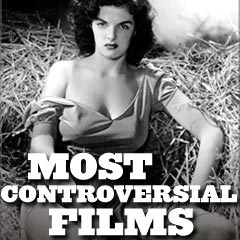
|
|
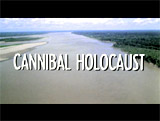
|
Cannibal
Holocaust (1980, It.)
This extremely graphic, hotly-debated cult classic Italian film from director Ruggero Deodato - was the uncredited inspirational precursor of the faux-documentary "found-footage" smash hit The Blair Witch Project (1999) - it was filled with violent, grisly, and disturbing images.
For his work on the film, the director was arrested by Italian authorities on suspicion of murder charges and faced life in prison, following its 1980 Milan premiere. He endured a trial when Italian authorities were unconvinced that the footage was indeed staged. Deodato lost the original trial, and all prints were to be destroyed, but he managed to have the ruling overturned in the early '80s when the actors finally appeared on TV to prove otherwise. Some five years passed before the film saw release in Deodato's home country. This movie was banned for twenty years in certain countries, including the UK. It opened with a reverse disclaimer:
The cannibal-exploitation film was purportedly the story of a four-person American film crew that disappeared while making a documentary (a feature entitled "The Green Inferno" - referring to the jungle itself) about the last surviving indigenous tribes that still practiced cannibalism in the wilds of South America's Amazon jungle area. The tribes in the area included the Yacumo, the cannibalistic Yamamomo (or Tree People), and their warrior-rivals the Shamatari (or Swamp People). The film began with a NYC reporter recounting the story of the group that entered the jungle on the border between Brazil and Peru. The entire film crew consisted of:
After their disappearance, the reporter told about a search and rescue mission that was undertaken, led by New York University anthropologist Harold Monroe (with two guides: experienced, bearded Venezuelan Chaco (Ricardo Fuentes) and his younger assistant Miguel). Along the way, they experienced a number of ghastly sights, including a skeleton of a corpse, and a brutal ritualistic "punishment for adultery" torture. It was performed by a native Yacumo husband against his young wife (Lucia Costantini) on a muddy lakeside. He violated her with a large wooden dildo and spiked ball of mud, followed by beating her to death. They also watched as rival tribes attacked each other, raped a young woman, and carved open another female. They realized that the filmmakers had caused unrest and great hostility among the villagers. Later after finding the more primitive Yamamomo tribe (and Prof. Monroe's naked swim with natives), they were led to a totemic shrine (with the skulls of the four crew members and pieces of photographic equipment) - evidence that the crew had been murdered. They participated in a grisly, ritualistic, cannibalistic feast (eating parts of the dead body of a Yamamomo criminal recently executed), before being allowed to take back the crews' film reels - footage of their journey into the primitive culture - in exchange for Monroe's tape-recorder. The reels were taken back to NYC for viewing. Masterful cinematic tricks and special effects created an unnerving view of the fate of the team - found in the undeveloped film cans of raw, unedited footage. Grisly, realistic-looking scenes (either realistic or staged) included:
The film's most notorious scene was next -- the discovery of the impalement of the young gang-raped female on a pole, with a pole inserted from her mouth to her genitals. (Was she punished by the natives, or was this a set-up by the film crew to obtain sensational footage?)
The Yamamomo tribe attacked the film crew, seeking revenge. Anders was hit by a spear, and then suffered male genital dismemberment followed by body mutilation, disembowelment, the display of guts, and cannibalism (the same fate befell Mark). Faye was stripped, raped, beaten by the women, and beheaded (her decapitated head was paraded around). Yates' death was filmed by his own dropped camera.
After viewing the horrific final reel of the unedited film of the sadistic, unethical, exploitative, offensive, culturally-insensitive film crew getting what they deserved, Monroe staggered out into the NY city street, lit his pipe, and in voice-over asked himself: "I wonder who the real cannibals are." |
 Guts-Eating: Cannibalism  Prof. Monroe's Discovery of Gory Skeletal Corpse - (Felipe)    Rape-Murder of Native Wife in Muddy Lakeside - Brutalized with a Wooden Dildo - For Committing Adultery  Yacumo Village Girls  Prof. Monroe Cavorting Naked in Water with Native Yamamomo Girls  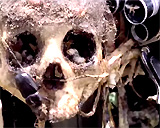 Totemic Shrine: The Four Skulls of the Fateful Yates Film Crew 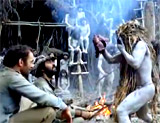 Yamamomo Cannibalistic Feast For Prof. Monroe - in Exchange For Film Reels  The Film Crew's Staged Yacomo Hut Burning - Resulting in Burned Natives 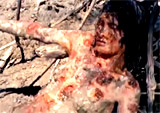 A Dying Elderly Native Woman 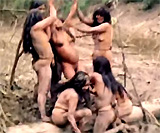 Forced Abortion and Destruction of Fetus 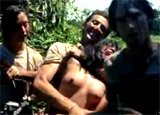 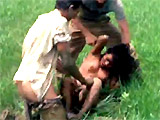 The Crews' Gang-Rape of a Yamamomo Girl 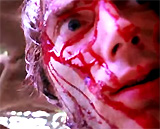 Yates' Death |
|||||||||||||||||||||||
  
|
Cruising (1980)
William Friedkin's notorious, grisly slasher-thriller film about a police investigation examined the seedy and dangerous underworld of gay S&M in NY's heavy leather bars (including The Ramrod). NY Times reporter Gerald Walker's 1970 novel of the same name was the basis for the dramatic yet repulsive film, about an NYPD police investigation to find a self-loathing homosexual serial killer who was targeting gays. It displayed actual leather-clad gay-bar patrons as extras in the meat-packing district rather than actors, and was considered a precursor to some segments of Irreversible (2002, Fr.). It received three Golden Raspberry nominations: Worst Picture, Worst Screenplay, and Worst Director (losing twice to Can't Stop the Music (1980) and to Xanadu (1980)). Two months after the film was released, a man killed two patrons and injured almost a dozen others at The Ramrod with a sub-machine gun. The originally X-rated film (eventually reduced to R after massive cuts) is currently truncated. It still lacks approximately 40 minutes of footage that were censored and edited out. [Note: Co-director James Franco's semi-documentary Interior. Leather Bar. (2013) reconstructed or "imagined" the missing 40 minutes of hardcore footage that were cut from the film.] It opened with a disclaimer:
However, major protests by gay groups - the first of their kind - accused the semi-exploitational film of being anti-gay and homophobic prior to the AIDS crisis for its depiction of the gritty, kinky, dangerous, sex-obsessed and depraved lifestyle of homosexuals. The film seemed to connect violence to the homosexual way of life. The protest centered around the film's ultra-provocative plot -- murders in gay nightclubs, and the film's negative, one-sided and stereotypical view of gays portrayed as crude psychopaths, sexual deviants, and sexual predators engaged in violent fetishistic activity and various hardcore sexual acts (i.e., a scene of fisting with a nearly naked man shackled and hanging from the ceiling). The film about an alternative or extreme lifestyle opened with three short scenes, beginning with:
The controversial film was centered around a police detective investigating the series of violent serial killer murders in the Big Apple's homosexual underworld, including the murder of Paul Vincent, a gay college professor at Columbia University:
He was dispatched by Capt. Edelson (Paul Sorvino) to locate and identify possible suspects and to serve as 'bait' for the killer. It was imperative for higher-ups in the law-enforcement chain that the case be solved before the Democratic National Convention came to town. Burns assumed the name "John Forbes," moved into a West Village apartment, and struck up an acquaintance with gay neighbor Ted Bailey (Don Scardino), an unemployed aspiring playwright, whose roommate was intensely-jealous, belligerent lover Gregory Milanese (James Remar) - an employed dancer who was paying the rent. Steve began to regularly frequent gay bars (such as the Ramrod, Wolf's Den, the Eagle's Nest, the Anvil, and the Cock Pit, among others) and observe the scene, where on one occasion, he was propositioned for sex by a gay man named Skip Lee (Jay Acovone), but he declined: "Not tonight"; a bit later, Burns was also asked to dance in the club by another male, as Skip looked on. Two more murders occurred:
Upon further investigation, Steve started to suspect that Skip was the killer (he was regarded by others as a "bad dude" and "scumbag"), since he worked as a busboy at a fancy Penn Station steakhouse known as The Iron Horse (with steak knives that conceivably matched the kiiller's weapon of choice from forensic photos). During a sting operation in a West 14th St. Motel room, Steve re-enacted the opening murder sequence with Skip (by requesting to be tied up on the bed butt-naked, while lying face-down), but they were interrupted mid-sex by nervous cops who busted in on them before anything transpired. At the police station during brutal interrogation of the suspect and Burns, a questionably campy scene, a large black man in thong underwear and a black Stetson cowboy hat inexplicably entered the room and slapped Burns, and then slightly later also punched Skip. Eventually, the suspect was declared innocent when his semen was tested to be normal, and the fingerprint on the quarter didn't match the kid's print. Burns was about ready to quit being undercover ("I don't think I can do the job, Captain"), because it was taking a toll on his relationship with Nancy. He feared that he had homosexual tendencies and at one point he told her: "Don't let me lose you," but then later began to lose his attraction to her; he told her: "What I'm doin' is affecting me." She suggested: "Maybe we should cut loose for awhile," and he agreed. He was pressured to continue the case by following up on a lead in the Paul Vincent murder (a gay Columbia Univ. professor) by questioning one of Vincent's former students (Stuart Richards) found in a yearbook photo. He was located living in an apartment in Morningside Heights, still pursuing graduate work in Columbia's Department of Music and Speech and writing his thesis on the roots of American musical theater.
Burns stalked Richards and broke into his apartment via the fire escape. He found evidence in letters that Richards had a dark history and a disapproving, deceased father (John Richards in St. Louis, MO). In a flashback, Richards remembered his father (dead for 10 years) urging him to seek homicidal reprisal against gays: ("You know what you have to do"). He donned black boots (hiding his knife), leather jacket, and police-hat to pursue his next victim. At the same time in his next-door apartment, Burns had a volatile altercation with his crazed gay neighbor Greg, where he attacked and a knife was drawn on him. Burns initiated a meeting with Richards, and in a frightening, climactic scene ending up in a park tunnel, Steve uttered the phrase ("Who's here, I'm here, you're here") and put on a police hat. He used homosexual lingo that he had learned to initiate sex, then defended himself against being stabbed, and actually put his knife in Richards' abdomen before arresting him - as the killer. Meanwhile, Burns continued to wear his leather-garb and visit gay bars even after the case appeared to be solved and the serial killer was apprehended. By film's end, the theme of the ambiguity of the killer's identity was still maintained. Steve's gay neighbor was found stabbed to death in his apartment with a kitchen knife -- and a last-minute scene opened up the suggestion that the sexually-confused Burns had taken on the persona of the killer. Had Burns killed Ted? In the final sequence after returning to his girlfriend's apartment, Nancy found parts of Steve's costume (the killer's costume = leather jacket, police hat, and pair of sunglasses) draped on a chair and tried them on. Meanwhile, Steve was in the bathroom shaving and engaging in a long meaningful look into the mirror at himself.
|
 Discovery of Severed Arm in Hudson River 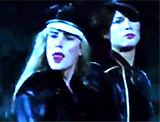 Two Transvestite Manhattan Prostitutes 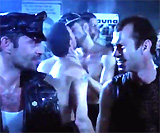 Gay Bar Scene 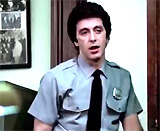 Police Detective Steve Burns (Al Pacino)  Murder Victim: University Professor Paul Vincent 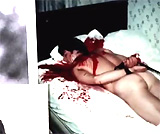 Murder Victim: Loren Lukas 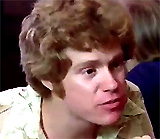 Gay Neighbor Ted Bailey (Don Scardino) 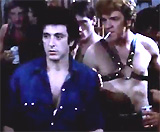 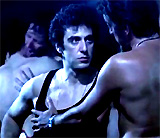 Scenes of Undercover in Gay Bar 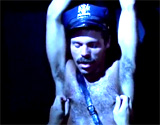 "Precinct Night" at One of the Gay Clubs 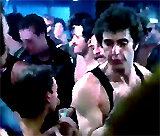 Burns Dancing with Male Partner 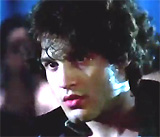 Prime Suspect: Skip Lee (Jay Acovone) 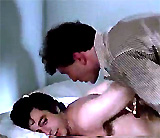 Aborted Sting Operation Against Innocent Suspect Skip Lee (Burns Was Tied Up on a Bed, At His Request) 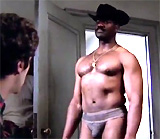 During Police Questioning of Burns and Skip - an NYPD Enforcer? 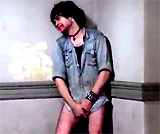 Demanding A Semen Sample From Skip 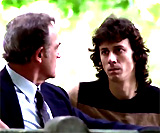 Richards' Dead Father Urging Him: "You know what you have to do" 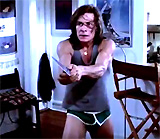 Gay Neighbor Greg Threatening His Knife at Burns 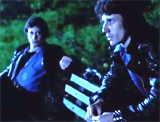 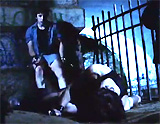 Burns Meeting the Killer in Central Park - and Stabbing Him During an Assault in Tunnel 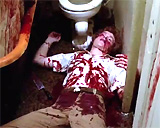 Steve's Gay Neighbor Ted Stabbed to Death |
|||||||||||||||||||||||
 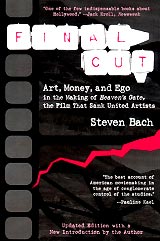 |
Heaven's Gate (1980)
This notorious, big-budget epic film was a major financial disaster for its studio (United Artists, the studio of Charlie Chaplin, D.W. Griffith, Mary Pickford and Douglas Fairbanks) - it also was a disaster for the western film genre for the remainder of the 80s, and it ended the reign of the New Wave of 1970's 'auteurs' or independent film-makers. Its self-indulgent, financially-irresponsible and excessive writer/director who had been praised for his Best Picture and Best Director-winning The Deer Hunter (1978), took the brunt of much of the film's criticism. Pretentious auteur director Michael Cimino was given unprecedented creative control (in the overindulgent, director-centric 70s era) and a large budget for the production of his long-brewing, flawed script titled The Johnson County War. Problems could have been forecast when the writer/director demanded that the film be titled "Michael Cimino's Heaven's Gate" ('Heaven's Gate' was the name of a roller-skating rink in the film). Difficulties became apparent when an entire town was created in Montana for the expensive, historically-recreated sets, and the shooting schedule quickly fell behind after repeated re-takes of each scene with a crew that was required to routinely work overtime. A number of poorly-paid extras in the production suffered accidental injuries, and the poor treatment of various animals in the film caused the ASPCA to protest. Even officials at Glacier National Park became exasperated at Cimino's disregard for preserving the public lands in their pristine condition. At the conclusion of location shooting, Cimino had filmed 220 hours of film, and then insisted on an additional prologue (a lavish opening dance sequence to the tune of Blue Danube (filmed at Oxford University in England)) at an additional cost of $5 million and a short epilogue (filmed in Rhode Island and San Diego) at an additional cost of $1 million. Its ballooning budget was almost six times above-budget to produce (from $7.5 million to about $44 million) with an additional amount for promotion amounting to about $11 million, for its overlong incomprehensible plot (originally a 5-hour 25 minute version that was cut down to 219 minutes), for its miscasting and slow pacing, for its expensive on-location shooting and fastidious over-attention to detail and historical accuracy, and for allegations of animal abuse - all for a film without major stars. Michael Cimino's expensive 'boondoggle' film and revisionistic Western became the biggest flop in film history at the time (US box-office was only about $3.5 million) - it lost at least $40 million when the final tally was taken - and since then has been synonymous for any film judged to be a monumental 'turkey' that faced major financial disaster.
Following its initial release in late 1980, the picture was immediately pulled from theatres (with further 'exclusive' showings cancelled), re-cut and then re-released six months later on April 23, 1981 in Los Angeles for its first theatrical release (after being shortened by 70 minutes down to 149 minutes) - but it still failed miserably due to more bad press and poor reviews. UA's corporate parent, Transamerica, was forced to sell the bankrupted studio to MGM for only $350 million as a result. The film's fiasco immediately caused the resignation of veteran studio president Andy Albeck, other top officials, and the firing of UA executive Steven Bach. [UA was responsible for earlier hits Midnight Cowboy (1969), Rocky (1976), Annie Hall (1977) and the James Bond films.] Bank-rolled support for independent 'auteur' directors of the New Wave of 70s directors (who controlled their own production costs with little studio oversight) ended when this film's egotistical director (nicknamed "The Ayatollah") was criticized as being self-indulgent, financially irresponsible and ego-driven. Heaven's Gate was one of the first films to be prejudged by a critic. The infamous review of New York Times critic Vincent Canby built negative press until Cimino's film was doomed to have an un-profitable theatrical release:
The film received numerous Razzie Award nominations (Worst Actor- Kris Kristofferson, Worst Musical Store, Worst Picture, and Worst Screenplay- Cimino), including a Worst Director prize for Cimino, although it received generally positive reviews after release to video, and fairly good results from its international box-office. It was critically re-evaluated by the LA-based Z Channel when it premiered on cable TV in its uncut version in 1982, but it was already too late. The ponderous and flawed film (with beautiful cinematography and art direction, but often muffled dialogue) included abundant nudity, violence throughout, a love triangle, a cock fight, a country-western roller-skating sequence, and a lengthy series of bloody battles and deaths at film's end. Its tagline represented the film as a romance-western:
It told about the Johnson County Wars between starving Eastern European immigrant farmers and mercenaries hired by the cattlemen. After its opening set-piece of couples dancing Strauss' Blue Danube waltz on the Harvard College lawn following graduation in 1870, its gorgeous cinematography by Vilmos Zsigmond continued with views of the panoramic Wyoming frontier landscapes - including the scene of a train bringing Eastern European immigrants to the West. In an early sequence set twenty years later, poor immigrant Michael Kovach (Aivars Smits) was brutally killed as a suspected rustler and illegal butcherer of cattle - leaving a round shotgun blast hole in a sheet - with the first view of bounty-hunter/killer Nathan Champion (Christopher Walken). The film's title was derived from the name of the town's dance hall and rink (Heaven's Gate), where during a roller-skating dance sequence, a young skating fiddler boy stirred up the audience. A love triangle developed between:
Averill first found romance on the Western frontier of Wyoming with Ella after he arrived and she served him pie for breakfast while stripping down at the table. She tempted him to hungrily follow her as she ran naked to the bedroom. He gave her a birthday present of a horse and rig. Shortly after she received the gift, they rode to a beautiful mountain stream where she went skinny-dipping in the refreshing water before they picnicked together and she talked about their future. 125 small farmer-immigrants were hunted down from a compiled death list, by a posse of hired mercenaries led by black-garbed and evil Frank Canton (Sam Waterston), the head of the Wyoming Stock Growers Association (with support from the cattle barons). Ella (on the 'death list') was forcibly raped, due to her "cash or cattle" deals as payment for her prostitutes. Averill sought revenge and shot and killed all but one of the rapists. Shortly later, an angered Champion entered Canton's camp and shot the remaining rapist - defying Canton ("You'd better have a guaranteed warrant for every name on that list"). Champion suffered a fiery death when he was killed in a barrage of gunfire outside his wall-papered frontier cabin (on fire) by the hired killers of evil cattlemen association leader Frank Canton. Champion had hastily written a farewell note to Ella knowing that he would die. There was a final two-day bloody showdown between the immigrants (with Averill joining their side) and the mercenaries hired by Canton and the Association (including the use of a Roman offense) - interrupted by the arrival of the US Army (with Canton in the lead) after the slaughter was essentially over. Also, there were surprising shock ambush killings at Ella's cabin of both Ella and John L. Bridges (Jeff Bridges), a local entrepreneur who had built the roller skating rink known as "Heaven's Gate." Sheriff Jim Averill shot back and killed Canton and his men, but his lost love Ella died in his arms (wearing a beautiful white dress). In the final almost wordless, despairing coda or epilogue scene, Averill now appeared miserable and unemotional about ten years later, quietly lost and adrift in his recollections as a rich yacht captain off Newport, Rhode Island in 1903 with his wife (his waltz partner from the opening scene, and the woman in the framed picture he kept with him). |
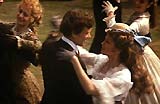 The Harvard College Lawn Whirling Waltz - 1870  Immigrant Train Arrival  Killing of Immigrant by Hired Killer Nathan Champion  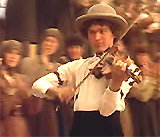 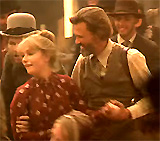 Roller-Skating Dance Scene in Heaven's Gate  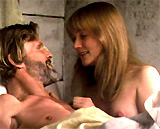 Sheriff Averill with Bordello Madam Ella Watson   Skinnydipping  The Johnson County Wars 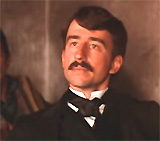 Frank Canton (Sam Waterston) 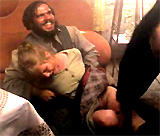 The Rape of Ella 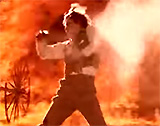 Death of Nathan Champion Outside His Torched Cabin 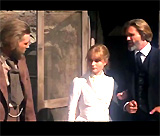 Before Ambush (l to r): Bridges, Ella, and Sheriff at Ella's Cabin 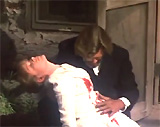 Ella Dead in Sheriff Averill's Arms 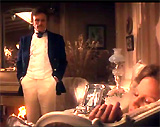 Epilogue in 1903: Sheriff Averill With Waltz Partner |
|||||||||||||||||||||||
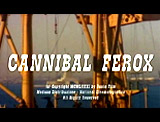
|
Cannibal Ferox (1981, It.)
(aka Make Them Die Slowly)
Umberto Lenzi's Italian exploitation 'cannibal' film was notorious for being one of the most banned and violent films ever made. It aspired to be as nasty and unwatchable as the previous year's Cannibal Holocaust (1980, It.), was often accused of being a rip-off, and was banned from viewing in dozens of countries. It exhibited gruesome death scenes and tremendous shock value for its explicit gore and gratuitous violence. Its opening included a warning statement about its barbarity:
The controversial film began with the murder (by mobsters) of an unnamed drug user in the NYC apartment of a despicable and exploitative drug-dealer:
Meanwhile, in an Amazonian jungle setting, three explorers set out to study the phenomenon of cannibalism:
Gloria's theoretical objective was to prove that cannibalism was a myth (an "invention of colonialism") - although she soon found out otherwise. Coke-snorting Mike had fled to South America (Colombia) along with his drug-dealing partner:
Told in flashback, both Joe and Mike began exploiting, torturing and abusing the natives to acquire their precious gems and drugs (cocaine), during a search for a cache of stolen emeralds. Mike treated the locals with sadistic disrespect and then blamed hostilities on the natives. They claimed that their alleged Portuguese guide was brutally tortured (with eye gouging), tied to a large wooden pole, castrated, and brutally killed by the cannibals, although Mike had committed the murder himself. To get out of the jungle alive with Joe, Mike kidnapped a young native girl (the native chief's daughter), although the two were pursued and attacked. Joe was badly-injured in the right shoulder and right leg The two groups met up in a deserted village, and soon slutty Pat was sexually seduced by Mike, helped with a dose of cocaine.
During a cocaine-fueled rage, Mike encouraged Pat to slowly kill the captive native girl with a knife, but went ahead and killed her himself with a gunshot when Pat resisted and the girl tried to flee. There were many questionable scenes, including various animal cruelties - a live parrot's head was ripped off and its innards were eaten, a tortoise had its body parts amputated before its belly was torn open, a furry creature tied to a post was eaten by a anaconda, a small crocodile was sliced open, and a piglet's belly was slowly cut open. Within a short period of time, the mistreated natives became aggressive, sought revenge and captured the entire group. After Joe succumbed to his lethal wounds, the angry natives discovered his body, dragged his corpse out of a hut, disemboweled him, pulled out his intestines, and ate them - as Gloria and Rudy watched from afar.
Mike was also caged, but fled into the jungle, although he was recaptured and treated harshly like the villager-guide he had previously tortured. He was castrated with a machete (his prized excised penis was eaten raw by the native chief and the painful wound was cauterized to prevent him from bleeding to death) while he was strung up on a large wooden pole. Then he was imprisoned underground. During an escape attempt while being transported to another village, Rudy's leg was bloodied in a jungle booby trap and he was attacked by fiercesome, blood-seeking piranhas when he hid in a pool of jungle water. Forced out of the water, a native shot him in the chest with a lethal poison blow-dart. Mike actually escaped again into the jungle - and upon recapture, his right hand was amputated (chopped off at the wrist) with a machete. A torturous 'meat-hook' death was inflicted upon feisty female victim Pat, as she was being watched by a group of female villagers. She was stripped of her shirt, poked in both breasts by a spear, and then iron hooks were pierced through both of her breasts - blood sprayed out as she screamed in intense pain. She was impaled by both breasts and suspended by ropes attached to the hooks to bleed to death in the Amazon jungle sun, as Gloria watched and begged for her to die quickly.
Mike was further restrained in a crude apparatus - positioned under a wooden table with a hole in it, through which the top of his head appeared. From there, natives chopped off the top of his skullcap with a machete to eat his reddish, gelatinous brains. An horrific and repulsive partial decapitation death method was the one in which Mike suffered and expired. By film's end, Gloria was freed by a sympathetic male native, and was able to reach safety and civilization when discovered by monkey traders, near death. Similar to the natives' version of events, Gloria confirmed that the others were in a canoe that capsized and they were consumed by crocodiles. A few months later back in NYC, she published her dissertation thesis titled Cannibalism: End of a Myth and received her doctorate degree in sciences and anthropology. Her writing was all a cover-up and a lie - and a distortion of her harrowing jungle experience. She was praised for her debunking of the idea or cruel myth - "the notion that man eats man" - and demonstrated that anthropophagy did not exist. Her reasoning was that the violence she had experienced was first inflicted upon the natives by her "civilized" and "superior" white society - and those acts of violence bred more violence. |
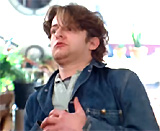 NY Mobster Murder of Drug User in Mike's Apartment 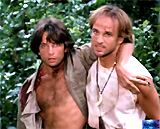 (l to r): Injured Joe and Mike 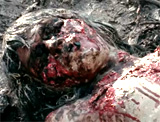 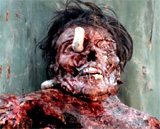 Corpses Found in 'Cannibal' Village 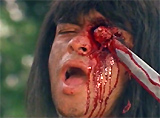 Flashback: Mike's Brutality Toward Portuguese Guide - Eye-Gouging (Followed by Castration and Death) 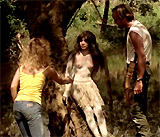  Native Girl - Murdered by Mike 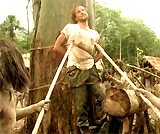  Mike's Machete Castration 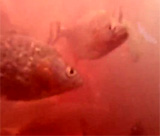 Piranha Attack on Rudy's Bloody Leg 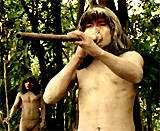 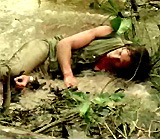 Rudy Shot and Killed with Poison Blow-Dart 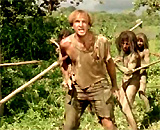 Mike Recaptured 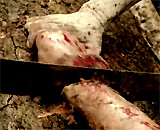 Mike's Hand Amputated 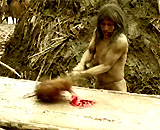 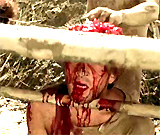 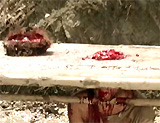 Mike's Brain Scalping, Decapitation, Slow Death and Brain Consumption 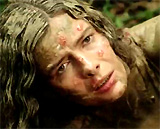 Near Death, Gloria's Rescue |
|||||||||||||||||||||||
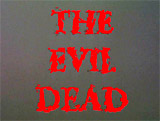
|
The
Evil Dead (1981)
This was the first installment of Raimi's Evil Dead trilogy, a low-budget, non-humorous B-grade horror film with the Stephen King quoted tagline: "The ultimate experience in grueling terror," with very little dialogue, plot or character development (with inexperienced actors). However, it was very successful at the box office, with a budget of only $350,000, it grossed $2.4 million (domestic), and much more internationally. The Evil Dead became a successful trilogy, helped Raimi on his way to becoming an A-list director, and turned star Bruce Campbell into a cult movie icon. However, due to the film's graphic violence, it was banned in several European countries. In the UK, the film was subject to obscenity trials and various censorship cuts - particularly the tree-rape scene. During the actual rape when penetrated, the besieged female made sexual moaning sounds and began to breathe heavily as if engaged in a sex act. On-screen blood, gore and sexual violence would have given the film an NC-17 rating if Raimi had presented the film to the ratings board when it was first released. This was the ultimate "cabin in the woods" film - with malevolent evil spirits being unleashed. Five Michigan State University students in their 20s were spending a weekend retreat in a rented, rustic and remote cabin in the Michigan mountains (some accounts say Tennessee). The group of five included Ash Williams (B-movie icon Bruce Campbell), Ash's younger sister Cheryl (Ellen Sandweiss), Ash's 'damsel-in-distress' girlfriend Linda (Betsy Baker), his friend Scotty (Richard DeManincor), and Scotty's loose girlfriend Shelly (Theresa Tilly). In the cellar, they found an archaeologist Professor Raymond Knowby's reel-to-reel tape-recording accounts of a mysterious, cursed, ancient and forbidden Sumerian book ("bound in human flesh and inked in human blood") named the Naturon Demonto (or Book of the Dead) - a book with a face on it, bound in human skin and inked in human blood. The professor had once lived there in the cabin, and had left the tapes behind. Unaware of the after-effects, they played one of the tapes of ancient spells and potent incantations (voice of Bob Dorian), and unleashed demonic forces, coming supposedly from the woods. They inadvertently raised from the dead dormant, demonic evil spirits from the ominous surrounding forest. Afterwards, one by one, each of them, except Ash, became violently possessed by 'evil dead' forces. Cheryl was the first person in their group to become a Deadite. The film's most controversial and scary scene, the infamous (and gratuitous) predatory tree rape scene, was accused of being misogynistic. In the scene, university student Cheryl ventured outside to find the source of strange noises, urging her: "Join us." She was attacked in the woods outside the cabin by prehensile tree branches and vines that wrapped around her neck and limbs. As the vines stripped her of her clothes, the unwilling Cheryl attempted to cover her bare breast for dignity's sake as the tree ripped her hand away. The branches caressed her and then forcefully spread her thighs and legs ("It was the woods themselves, they're alive") - one large tree branch suddenly impaled her in her crotch to oppressively penetrate her.
Soon after, she was chased back to the house (with quick POV tracking shots), where she was soon transformed into a demon zombie with a greyish white face and superhuman strength (known as a Deadite or Shemp). As a result, she levitated or floated above the floor, spoke with a ghastly voice (screaming: "You will die!" and "One by one, we will take you"), and grabbed a pencil from the floor and jabbed it into the ankle of Ash's girlfriend Linda (Betsy Baker). Scotty hit her in the face with the handle of an axe, and managed to chain her up in the basement. Cheryl was confined in the basement cellar with a padlocked trap-door opening in the living room. Only Ash escaped being taken over by 'evil dead' forces by film's end. |
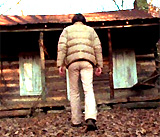 The Remote Abandoned, Rented Cabin in the Woods 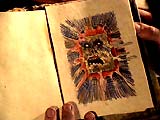 Book of the Dead or Necronomicon Ex-Mortis in the Cellar 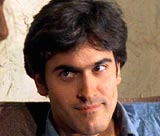 Ash Williams (Bruce Campbell)  Cheryl (Ellen Sandweiss) 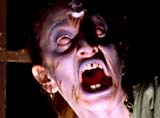 Cheryl Transformed into Zombie  Cheryl Stabbing Linda's Ankle  Cheryl Confined in Cellar |
|||||||||||||||||||||||
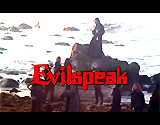
|
Evilspeak (1981) Director Eric Weston's grindhouse horror film's title referred to a computerized Black Mass ritual that unleashed terror upon a group of tormentors. The gorefest was released in both R-rated and uncut versions, for its extreme violence and nudity. It was notorious for being labeled a "video nasty" by the UK in the 1980s - and therefore faced censorship, was prosecuted, and refused certification and release. Eventually, it was released with 3 minutes and 34 seconds cut in 1987, and in a fully uncut version in 2004. Its tagline was:
The basic plot was encapsulated in another tagline: "Data incomplete... Human blood required. Thus spake the computer." The film opened with a title card prologue:
Under the opening credits at an unidentified Spanish shoreline, evil and Satanic black-hooded priest Father Lorenzo Esteban (Richard Moll) was excommunicated and banished (along with his followers) from Spain by priests in the Holy Roman Church during the Inquisition in the 16th Century, for practicing Satanism and blasphemy. He was told: "Nothing can protect you from the wrath of God or the Avenging Angel." After being sent away, the contemptuous Father spit in the priest's face before walking down to the beach to a group of his own devil worshippers for a ritualistic sacrificial ceremony at a funeral pyre. He drew a 5-pointed pentagram symbol with his sword in the sand. Then he stripped the top from a brown-haired, peasant-girl (Nadine Reimers), raised his sword, and with one swing, decapitated her.
The film - with the arcing swing, transitioned to the present day of the early 1980s, and the kicking of a soccer ball on a field in California. After the game in the locker room, one of the West Andover Military Academy cadet players - chubby and orphaned Stanley Coopersmith (Clint Howard, brother of director/actor Ron Howard), was bullied and tormented by teammates for his poor playing, causing the game's loss. Furthermore, he was outcast and treated badly by teachers and staff, the Coach, the Colonel and even the local Reverend. Stanley found an ancient Latin tome (Esteban's diary or magic book?) in a secret walled-off chamber of the academy's chapel basement when he was ordered to clean it as punishment. Through a brick wall and in a dark room, he found the book of Black Mass rituals marked with a jewel-encrusted pentagram emblem on the cover. He also noticed a fetus in a jar that was moving. As he was being grabbed in the neck by an arm bursting through the wall and confronted by Esteban himself, Stanley suddenly awoke from a frightening nightmare. Stanley was able to decipher (through his computer's translation program) what Esteban had written in three different diary entries in the 16th century, and translate the entries into English. The three entries described Esteban's plan of seeking revenge.
Stanley also used his computer to research the occult, in order to find out how to seek his own vengeance against bullies and other school officials. He typed in his prayer: "Satan, hear my plea and through the rite of the Black Mass help me stand erect before my enemy and defy his curse." Conveyed through his computer, Stanley learned that the invocation and items required to lead a Black Mass occult celebration and conjure up Satan included: mandrake root, juice of aconite, poplar leaves, arsenic, sulphur, black candles, unholy water, and human blood from a consecrated host. Stanley's first attempt to seek revenge by performing the Black Mass failed, because he hadn't acquired blood. In one of the film's earliest death scenes after successfully performing the ritual - causing the computer screen to flash a pentagram, an unseen demonic power twisted the head of the drunken school custodian/caretaker Sarge (R.G. Armstrong) 180 degrees. After the murder, Stanley hid Sarge's body in catacombs, where other skeletal remains (decapitated) and Esteban's crypt were located.
In a scary scene, the school's secretary Miss Friedemeyer (Lynn Hancock) was the next victim to be punished for stealing Esteban's diary after Stanley accidentally left it on her desk. When she finished taking a shower in a very gratuitous scene - she opened her bathroom door and a herd of evil, vicious, demon-spawned carnivorous black pigs attacked, mauled and devoured her (and pulled off bits of her entrails and flesh) after she fell backwards into her bathtub. The stolen Esteban diary slowly vanished from her desk. Stanley became distraught when he discovered that the persistent bullies on his soccer team, led by Douglas "Bubba" Caldwell (Don Stark), had killed his puppy dog Fred. With superhuman strength, Stanley hurled teacher Hauptman (Hamilton Camp) into an overhead, hanging wooden, circular-shaped chandelier, where his head was impaled on one of its spikes - the blood conveniently drained into a goblet below, and now enabled Stanley to conduct his Black Mass ritual, to exact his own revenge on his tormenters. He drank the blood from the goblet and was empowered. In the final 20-minute slaughter sequence (censored and edited in some versions) in the basement and barricaded chapel that trapped the students inside, there were numerous deaths when Stanley devoted himself to Satan and his body was possessed by the vengeful Esteban. [Note: The scene was reminiscent of revenge by the bullied protagonist of Carrie (1976)].
The film ended with an epilogue:
On a demonic computer screen, a spinning pentagram was replaced by red text - and Esteban's name was replaced with Stanley's:
Then, Stanley's face filled the screen before the closing credits. |
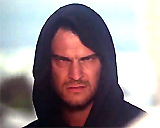 Evil Satanic Priest - Father Lorenzo Esteban (Richard Moll) Excommunicated and Banished by the Holy Roman Church  Esteban Exalted by His Devil-Worshipping Followers on the Shoreline 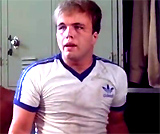 Young Outcast and Bullied Cadet Stanley Coopersmith (Clint Howard 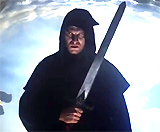 Vision of Esteban to Stanley 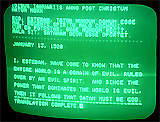 Stanley Deciphering a Black Mass Ritualistic Book Via a Computer 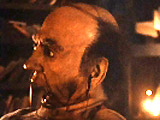 Head-Swiveling Death of Drunken School Caretaker-Custodian Sarge (R.G. Armstrong) 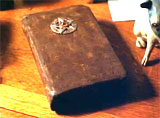 The Stolen Esteban Diary (with a Jewel-Encrusted Pentagram Symbol)  Death of Teacher Hauptman - Thrown Upwards Into Chandelier and Impaled There 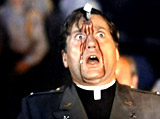 Crucifix Nail-Forehead Death of Rev. Jameson 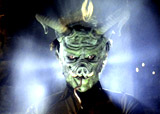 Stanley Transformed into Demonic Creature 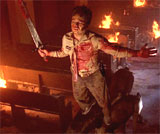 Stanley Levitating, and Seeking Revenge With A Sword  Stanley's Sword Head-Splitting of Colonel Kincaid 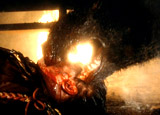 Body-Chomping Ravenous Pigs Biting at a Student's Skull  Lead
Bully Bubba's Still-Beating Heart Ripped Out by 'Reanimated'
Sarge Lead
Bully Bubba's Still-Beating Heart Ripped Out by 'Reanimated'
Sarge   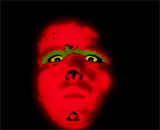 Epilogue: Stanley's Revenge: "I WILL RETURN" |
|||||||||||||||||||||||
(chronologically, by film title) Intro | Silents-1930s | 1940s-1950s | 1960-1961 | 1962-1967 | 1968-1969 1970-1971 | 1972 | 1973-1974 | 1975 | 1976-1977 | 1978 | 1979 1980-1982 | 1983-1986 | 1987-1989 | 1990-1992 | 1993-1995 | 1996-1999 2000-2002 | 2003-2005 | 2006-2009 | 2010-present |